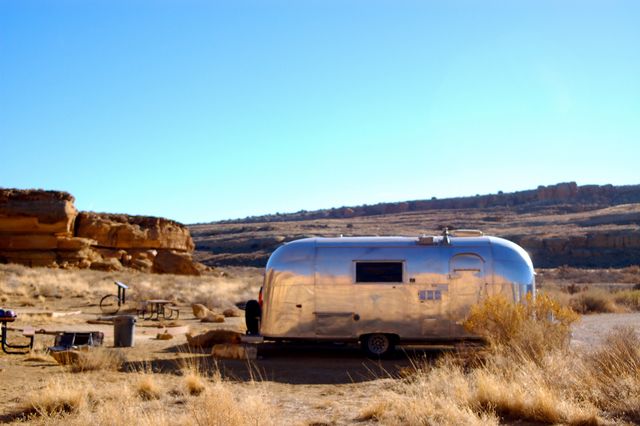
This year we decided to do something different for Thanksgiving. Instead of traveling to be with extended family or entertaining them here, we opted to stay put in Santa Fe and keep it simple. But when we fished around for an invitation to a proper Thanksgiving dinner and came up empty, staying home no longer seemed so festive. What would be more exciting than turkey for four around our dining room table? An Airstream road trip!
All fall, we’d been wanting to go to , a rugged valley in northwestern New Mexico that, a thousand years ago, was a major trading center for Native Americans. Today it’s a wild, desolate landscape dotted with crumbling ruins, a campground and visitor center, and not a single tree. From there, we’d head to , a 30-mile-long chasm on the Navajo Nation in Arizona. Both are World Heritage Sites and have major historical significance to the native peoples of the Southwest. It seemed a perfect, semi-spontaneous way to celebrate Thanksgiving—deep in the heart of Indian country, immersed in a culture that preceded our own by centuries.
This would be our fourth trip in the Airstream in the past six months, but our first in winter-like conditions. Chaco sits at about 7,000 feet in the high desert, and nighttime temperatures were forecast to dip into the low 20s. Our 1961 trailer has a propane wall heater, but we’d never turned it on and it looked sketchy at best, lethal at worst. A couple nights before we left, Steve went out to the Airstream with a box of matches and a carbon monoxide alarm. It took him a few tries to get the furnace lit, and when he did, the alarm immediately started beeping. An hour later, we could still hear it shrieking from inside the house. “It won’t get that cold in the Airstream,” he reasoned hopefully. “We can always turn it on during dinner to heat the place up, then shut it off when we go to sleep.”
Just in case, I threw in piles of warm blankets, comforters, extra sleeping bags, a couple layers of long underwear for the girls, and plenty of extra socks. I’d been feeling a little forlorn about missing out on a traditional meal altogether, so for exactly half a second I basked in the rosy image of us roasting a turkey in the tiny Airstream oven, maybe even baking cornbread in the Dutch oven we don’t own. Then I promptly went out and sourced an entire pre-made Thanksgiving picnic from the Whole Foods deli: cranberry sauce in a plastic to-go container, a pound of roasted turkey breast, a carton of stuffing, a box of wine, and half a pecan pie.
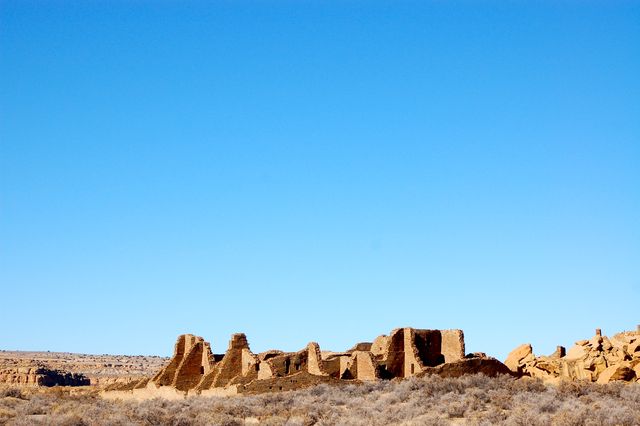
Even for New Mexico, where open spaces and distances are so vast that they seem to take on another dimension, Chaco is remote. It’s 20 miles from the nearest pavement, and the road in is legendary. Though officially it’s a National Historic Park, managed by the park service, once you get there, there are no services. Tell anyone you are going to Chaco, and the first thing they will do is groan in horror and say, “Oh! That road!” It has the reputation of being spectacularly bad: a rutted, washboarded rumble strip that becomes impassable when it’s wet. Fortunately, or unfortunately, it’s been scarily mild and dry here in New Mexico all fall, and the chance of precipitation was holding steady at a big fat zip. When people looked aghast at the idea of towing our decrepit trailer on that sorry excuse for a road, I scoffed a little on the inside. I’d been down it before. Really, how bad could it be?
By the time we turned off the highway south of the next-to-nothing-outpost of Nageezi just after noon on Thanksgiving Day, we were filled with that delusional euphoria you get when you’ve miraculously survived nearly three hours in the car without a single meltdown (which, in retrospect, is really a sign that the shit is about to hit the fan). We bounced along the bumpy road, past dilapidated houses with broken windows and half blown-off roofs, windmills that hadn’t spun in years, and traditional round Navajo hogans, with their doors facing east. Except for a half-mile stretch of cavity-loosening washboards that seemed to want to suck us in, like a set of rowdy, monster waves, the road didn’t seem all that much worse than other dirt roads around the West. I actually thought, and was about to tell Steve, “This isn’t that bad,” but it seemed too obvious to bother saying out loud. We were doing 20 or 30, and ahead of us, Chaco’s iconic, square-topped Fajada Butte grew bigger, fast.
One of the big bonuses of cold-weather camping is that you don’t have to reserve sites in advance or worry about getting shut out of first-come-first-served campgrounds, like the one in Chaco. When we pulled in, there were half a dozen trailers fanned out around the loop, but we had our pick of nice spots and chose one along the canyon wall and set about unpacking.
The lock on the Airstream’s door has been broken since we bought the trailer last year, and to keep the door from flapping open incessantly, Steve devised a laborious system that involves a piece of rusty wire from a landscaping flag and a cable lock. I was unloading the girls’ bikes from the back of the truck when Steve wrestled the door open. I couldn’t see him, but I heard him. He didn’t scream or gasp or curse. He just moaned, a low and terrible “Ohhhhhh.”
“Wait here,” I told the girls and hustled over to the trailer. Steve had his head in the door, and I peered in nervously. Inside, a bomb had gone off. The Airstream had exploded, spewing its contents everywhere: the propane heater had come off the wall and lay in pieces on the floor. The small kitchen table that doubles as the girls’ bed had jiggled off its flimsy hinges. The glass window above our bed was missing; all that remained was the screen. “It’s destroyed, totally destroyed.” Steve groaned. He looked like he wanted to throw something, but everything was already trashed.
Ever since our first trip to Marfa in the spring, Steve had been threatening to put the Airstream on Craiglist. It was too old. Something was always breaking. Plus, we like sleeping outside. But I kept stalling. I wasn’t ready to give up on it so soon. But now, surveying the destruction, I could see it was over. No amount of vintage charm or creature comforts were worth the headache of being shackled to this ancient, broke-down trailer that sent Steve into hysterics every time he towed it. “OK!” I cried, throwing my hands in the air. “You don’t have to convince me anymore. We can sell it. But please let’s not let it ruin Thanksgiving.”
We’d only been gone for a few hours, but already we’d come to the critical juncture in the trip: the point where things can go one way, or the other, and once they do, it’s hard to reverse the tide. Steve was cursing under his breath and stomping around, livid. The girls were whining for their bikes and helmets. But it was a glorious sunny day and all of Chaco Canyon opened up around us. We’d brought tamales for lunch. We could wallow in the frustration of our ruined trailer or we could have a picnic and ride our bikes up the road to see some ruins.
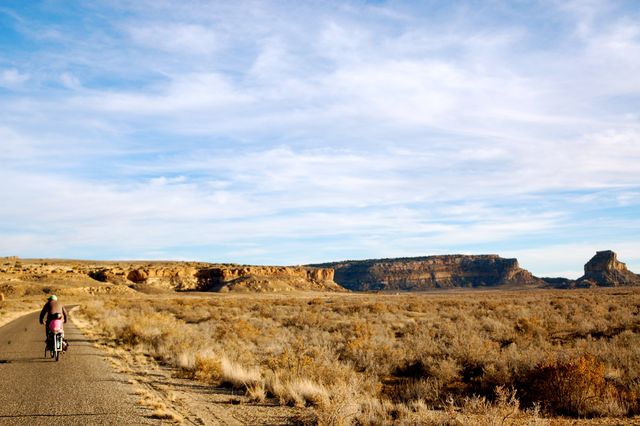
One of the great ironies of Chaco Canyon is that once you survive the wretched ride in, the main park road—a nine-mile, one-way loop past five major ruins—is paved. The asphalt’s so smooth, and there’s so little traffic, you could inline skate straight down the middle. In other words, it’s perfect for family biking. We saddled up, Pippa on a new and Maisy on the cargo bike behind Steve, and rode the mile to the visitor center. The park maintains miles of rambling, mostly-flat trails that wind among the ruins and are short enough for even young ones to hike. We were running out of daylight, so instead of heading straight to Pueblo Bonito, the largest excavated ruins in the park, we biked instead to Hungo Pavi, two miles away.
There are more questions than answers about who lived in Chaco during its heyday, between 850 and 1250 A.D., and why they left. But one thing is indisputable: their architecture was astounding. Chacoans built monumental complexes, or “great houses,” with hundreds of multi-story rooms, plazas, and ceremonial kivas constructed from local sandstone. They chiseled the stone into precise blocks, stacked one upon the next and mortared them with mud. Many of the excavated walls still stand, stick straight, a thousand years later. At Hungo Pavi, one of the smaller complexes in the canyon, you can see the gnarled old wood beams, harvested some 50 miles away in the Chuska Mountains and hauled back to shore up the buildings.
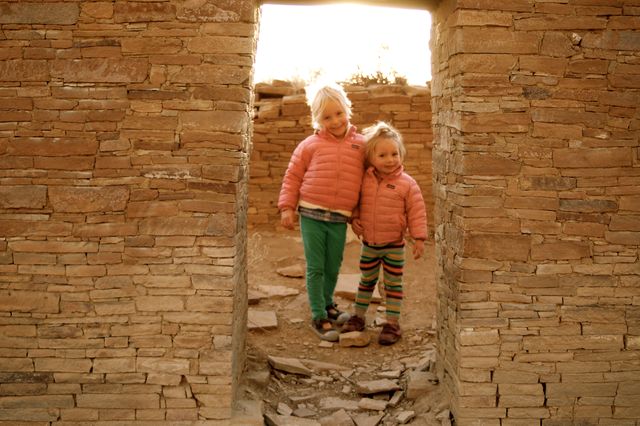
Back at the campground in the fading light, it was time for Thanksgiving dinner. Steve had reassembled the Airstream’s broken parts as best he could with a screwdriver, and taped a garbage bag over the shattered window to keep the draft out. The propane heater wouldn’t light, though, but the oven did, so we put the turkey breast, sweet potatoes, and stuffing in to heat, and felt the trailer begin to warm almost instantly. The girls sat at the kitchen table drawing handprint turkeys with crayons, and Steve cracked a beer. ���ϳԹ���, the temperature was dropping fast, but the Airstream felt cozy and purposeful, like a bustling restaurant kitchen shrunken down to miniscule proportions.
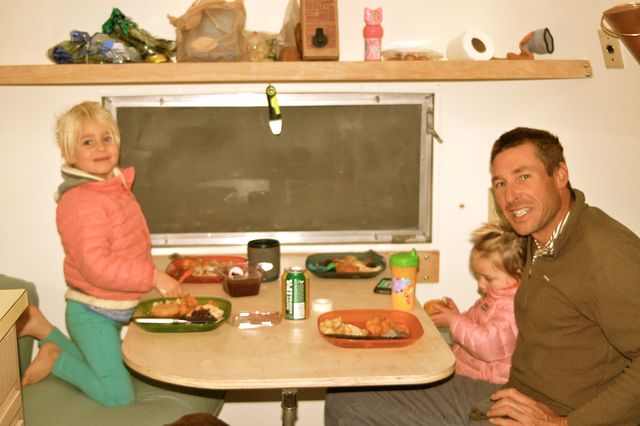
I’ve eaten fancier holiday meals in my life, but the novelty of Thanksgiving in the backcounty and the ambiance of eating by headlamp in a vintage trailer totally trumped the food’s store-bought taste (and the Airstream's ricketiness). Pretty much everything—even deli-cut slabs of turkey breast and cold cranberry sauce—tastes better in the wild. The coup de grace was the pecan pie, warmed to hissing perfection in the oven while Steve and the girls built a campfire outside. The sky was wall-to-wall stars, and we roasted marshmallows, bundled up in all our layers, until the girls asked to go to bed.
The second best thing about cold-weather camping, after being able to show up spontaneously and pick the best site, is that kids go to sleep when it gets dark, which in late November is practically the middle of the afternoon. By 7:30 they were both zonked out, head to toe, in the narrow bed up front, under piles of blankets, with the oven still running for extra warmth. That gave Steve and me a couple hours of uninterrupted downtime to hang out and talk and read and write by the fire—an unheard of luxury on summer campouts, when they run wild until well after nine. Sure, we were wearing hats and mittens and every piece of outerwear we had, but to sit there in Chaco’s black and awesome silence was so heavenly it was easy to ignore the chill.
In the morning came the triumph of having survived a night of sub-freezing temperatures followed quickly by the sluggish dread of having to get out of bed. It was bitter cold inside the Airstream, the oven having been turned off in a melodramatic fit of middle-of-the-night carbon monoxide poisoning panic. “Smoke is coming out of my mouth,” Pippa said as she crawled in next to us shortly before dawn. “That’s steam from your breath,” I told her, pulling her warm body next to mine.
The sun inched above the low canyon walls, hitting the campground early and warming things up slowly. Oatmeal and hot chocolate helped, and by 10 we were packed up and ready for one last hike before pushing on to Canyon de Chelly. We wound through the maze of stone walls at Pueblo Bonito, staring down into enormous, round, 20-foot-deep kivas, and stooping through stubby doorways. A raven flew above thousand-year-old petroglyphs etched into the canyon wall, its shadow dipping and bending with the folds in the rock. If you want to be reminded of the impermanence of life and the weird elasticity of time, there’s nothing better than watching your children scamper among the ghostly outlines of a once-vibrant civilization long vanished. Young and old—each, in their own way, so fleeting.
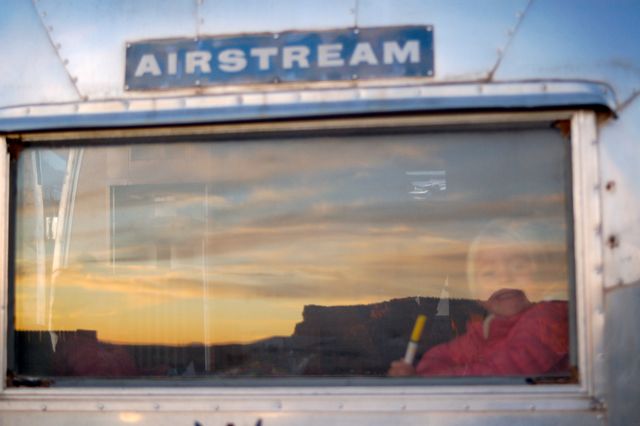
We were reluctant to leave Chaco. And not just because we were dreading the drive out, the same rivet-rattling, glass-shattering road we’d come in on. The emptiness of the canyon was exhilarating. It was so quiet, even the wind made no sound, and in the stillness you could feel the presence of something old and timeless. I could have stayed for days, riding the loop road, wandering among the great houses, sitting by the fire under the blinding stars, holing up in our sorry little patched-together trailer. But it was time to batten down the hatches, padlock the door, and shake, rattle, and roll our way to Canyon de Chelly. That is, if we make it.
For more information about visiting Chaco, go to .
—Katie Arnold